
Introduction
We have with us now the latest 27" sized
screen from ViewSonic in their Professional range. The VP2768 is aimed at
professional applications and colour critical work, while maintaining a
competitive price point. Rather than go the route of offering a wide gamut
backlight, at an additional cost, ViewSonic have stuck with a standard sRGB
gamut screen, but packed it with other features suitable for these uses. The
VP2768 features an IPS panel for stable and reliable colour quality, factory
calibration with dE <2, 14-bit 3D LUT (Look Up Table), a uniformity correction
feature and even hardware calibration support. The screen also offers a 4-side
borderless design, and Daisy-chaining from a single DisplayPort cable making it
a suitable option for multi-screen setups. It's not been officially released yet
in Europe so we have a very early look at this display to put it through
its paces.
If you appreciate the review and enjoy reading and like our work, we would welcome a
donation
to the site to help us continue to make quality and detailed reviews for you.
|
Check Pricing and Buy - Direct Links
|
|
Amazon
|
|
TFTCentral is a participant
in the Amazon Services LLC Associates Programme, an affiliate
advertising programme designed to provide a means for sites to earn
advertising fees by advertising and linking to Amazon.com, Amazon.co.uk,
Amazon.de, Amazon.ca and other Amazon stores worldwide. We also
participate in a similar scheme for Overclockers.co.uk. |

Specifications and Features
The following table gives detailed information
about the specs of the screen:
|
Monitor
Specifications |
|
Size |
27"WS |
Panel Coating |
Light AG coating |
|
Aspect Ratio |
16:9 |
Interfaces |
1x DisplayPort,
1x Mini DP, 2x HDMI 1.4, 1x DisplayPort Out
|
|
Resolution |
2560 x 1440 |
|
Pixel Pitch |
0.2331 mm |
Design
colour |
Matte black plastic bezel,
stand and base with glossy section on base |
|
Response Time |
14ms G2G |
Ergonomics |
Tilt, 130mm height, swivel, rotate |
|
Static Contrast Ratio |
1000:1 |
|
Dynamic Contrast Ratio |
20 million:1 |
VESA Compatible |
Yes 100mm |
|
Brightness |
350 cd/m2 |
Accessories |
Power cable, DisplayPort >
Mini DP cable, USB cable |
|
Viewing Angles |
178 / 178 |
|
Panel Technology |
LG.Display IPS |
Weight |
with stand: 6.88 Kg |
|
Backlight Technology |
W-LED |
Physical Dimensions |
(WxHxD)
613 x 540.4x 215 mm |
|
Colour Depth |
16.7m (8-bit) |
|
Refresh Rate |
60Hz |
Special
Features |
4x
USB 3.0 ports, audio out, uniformity correction, hardware calibration,
factory calibration report |
|
Colour Gamut |
Standard gamut
sRGB, ~72% NTSC |
The VP2768 offers a decent range of connectivity
options with 1x DisplayPort 1.2, 1x Mini DisplayPort and 2x HDMI 1.4
connections offered. There is also a DisplayPort out connection for
daisy-chaining multiple displays if you need. The
digital interfaces are HDCP certified for encrypted content and the video cables
are provided in the box for DisplayPort to Mini DP only.
The screen has an internal power supply and comes
packaged with the kettle-type power cable you need. There are also 4x USB 3.0 ports located
on the back of the screen with the video connections. An audio out connection is also provided
if you need it.
Below is a summary of the features and connections
of the screen:
|
Feature |
Yes / No |
Feature |
Yes / No |
|
Tilt adjust |
 |
DVI |
 |
|
Height adjust |
 |
HDMI |
 |
|
Swivel adjust |
 |
D-sub |
 |
|
Rotate adjust |
 |
DisplayPort |
 |
|
VESA compliant |
 |
Component |
 |
|
USB 2.0 Ports |
 |
Audio connection |
 |
|
USB 3.0 Ports |
 |
HDCP Support |
 |
|
Card Reader |
 |
MHL Support |
 |
|
Ambient Light Sensor |
 |
Integrated Speakers |
 |
|
Human Motion Sensor |
 |
PiP / PbP |
 |
|
Touch Screen |
 |
Blur Reduction Mode |
 |
|
Factory calibration |
 |
G-Sync |
 |
|
Hardware calibration |
 |
FreeSync |
 |
|
Uniformity correction |
 |
Wireless charging |
 |

Design and Ergonomics

Above: front views of the screen and stand
The VP2768 comes in a black design with
predominantly matte plastics used. There is a 4-side zero frame design to this
model, with the outer plastic bezel measuring only 2mm around all four edges.
There is also a 6mm black panel border around all sides, so the actual total
black edge is about 8mm. It still looks very thin and makes the screen very
suitable for multi-monitor setups. ViewSonic have kept the edges nice and thin
by not adding any branding logos, and by locating the OSD control buttons on the
back right hand side of the screen.


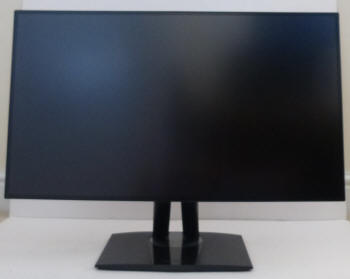
Above: front views of the screen. Click for larger versions
The monitor arm and base are matte black
plastic also, with the exception of a triangular glossy black section in the
middle as you can see from the below picture. The stand provides a decent,
wide and sturdy base for the screen and seems very stable.
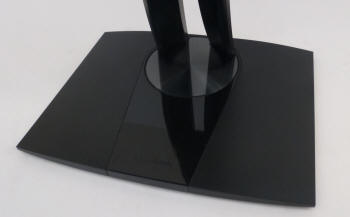
Above: view of the base of the stand. Click for larger versions

Above: rear views of the screen
The back of the screen is enclosed in a matte
black plastic with a large ViewSonic logo at the top. The stand attaches
in the centre and can be removed for VESA 100 compliant mounting options if you
wish. You have to screw this on when you first set up the screen as it is not a
quick release stand bracket. You can see the OSD control and power buttons on the left hand side of the
image (when viewed from behind).

Above: side view. Click for larger version
The screen has a fairly thin profile as you
can see from the above image, although overall it's a deeper footprint because
of the slightly curved stand and deep base.
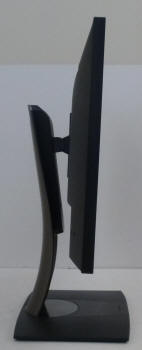
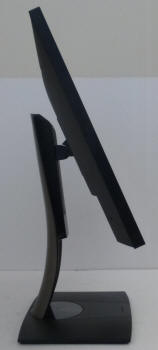
Above: full tilt range shown. Click for larger versions
There is a decent set of ergonomic
adjustments offered from this screen. Tilt is smooth and easy to use and offers
a reasonable range of adjustment as you can see from the above pictures.
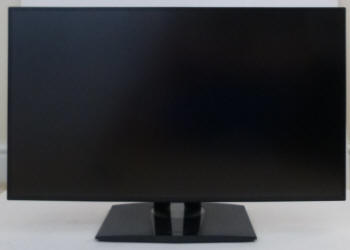
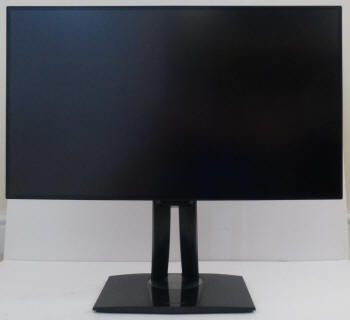
Above: full height adjustment range shown. Click for larger versions
Height
adjustment is a little bit stiff but offers smooth movements as well, with a
total adjustment range of 130mm. At the lowest setting the bottom edge of the
screen is ~60mm from the edge of the desk, and at maximum extension is is
~190mm. Side to side swivel is a little bit stiff but again offers smooth
movements and a wide range. The base of the stand stays firmly positioned on the
desk as you move the screen side to side. Rotation in to portrait mode is a
little bumpy but easy enough to use and might be useful to some users.
A summary of the ergonomic adjustments
are shown below:
|
Function |
Range |
Smoothness |
Ease of Use |
|
Tilt |
Yes |
Smooth |
Easy |
|
Height |
120mm |
Smooth |
A bit stiff |
|
Swivel |
Yes |
Smooth |
A bit stiff |
|
Rotate |
Yes |
Moderate |
A bit stiff |
|
Overall |
Good range of adjustments
and smooth movements, mostly easy to use. No wobble |
The materials were of a good standard and the
build quality felt very good as well. There was no audible noise from the screen,
even when conducting specific tests which can often identify buzzing issues.
The whole screen remained cool even during prolonged use as well which
was pleasing.


Above: connection options on the back of the screen. Click for larger
version (bottom picture)
The back of the screen features the
connections. To the left is the power connection. You only need a normal
kettle lead here as the power supply is built in to the screen. There are then
2x HDMI, DisplayPort, Mini DisplayPort, DisplayPort out (for daisy chaining),
audio out, USB upstream and 4x USB 3.0 downstream connections. It would have
been handy if some of the USB ports were on the side of the screen for easier
access.

OSD Menu

Above: OSD control buttons on the back right hand side of the screen (viewed
from front). Click for larger
version
The OSD menu is controlled through a series
of 5 pressable buttons located on the back right hand edge of the screen. There
is also a power on/off button beneath these which feels a little different to
the touch. We found that the buttons were sometimes a bit fiddly to use, as it's
not always intuitive to know which button you're pressing, or which ones you are
hovering over at the back. This can result in wrong presses, and sometimes even
an accidental power off if you stray too low.
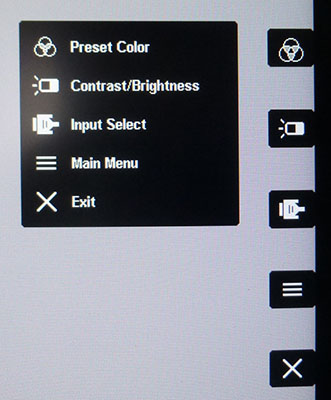
Pressing any of the OSD buttons pops up the
above quick launch menu, along with some labels on the right hand edge of the
display to help guide you to the appropriate button on the back.
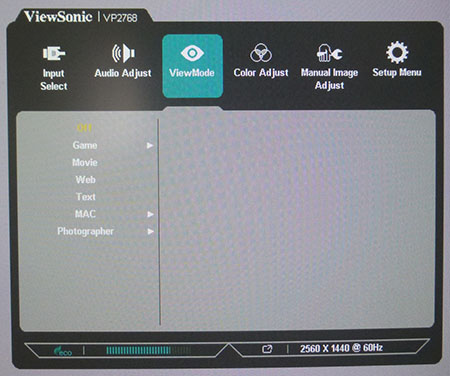
The menu is split in to 6 sections shown
across the top and you can scroll between them to reveal the relevant options
available underneath. The input and audio menus are self explanatory. The above
'ViewMode' menu gives you access to the range of preset modes for different
uses.
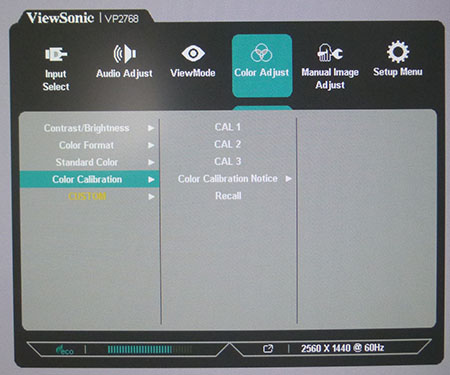
The 'Color Adjust' section allows you to
change brightness, contrast, access the factory calibrated colour modes (e.g.
the sRGB mode), the hardware calibrated modes and also the custom settings where you can
adjust the RGB values yourself for
manual
calibration.
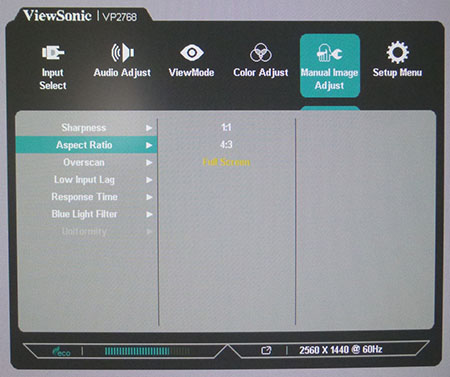
The 'Manual Image Adjust' section has some
useful options as well, including the aspect ratio control, overdrive levels
(Response Time setting) and the Low Input Lag settings. We will test all of
these later on in the review.
Overall there was a very good range of
options available and the software was responsive. It wasn't very intuitive
though and felt a bit cumbersome sometimes trying to get to the option you
wanted.

Power Consumption
In terms of power consumption the
manufacturer lists typical usage of 32W, maximum of 35W and 0.3W in standby. We carried out our normal tests to
establish its power consumption ourselves.
|
 |
|
State and Brightness
Setting |
Manufacturer Spec (W) |
Measured Power Usage
(W) |
|
Default (100%) |
32.0 |
30.3 |
|
Calibrated (25%) |
- |
16.7 |
|
Maximum Brightness (100%) |
35.0 |
30.3 |
|
Minimum Brightness (0%) |
- |
12.9 |
|
Standby |
0.3 |
0.6 |
|
We tested this ourselves and found that out of the
box the screen used 30.3W at the default 100% brightness setting. Once calibrated the screen reached
16.7W consumption, and in standby it
used only 0.6W. We have plotted these results below compared with other screens
we have tested. The consumption is comparable to the other 27" sized
screens we have tested as you might expect, with some of the smaller screens
drawing slightly less power (comparing the calibrated states). Those with wide
gamut support like the ViewSonic VP2772 and NEC PA271W draw more power because
of their backlight units, despite being the same size as this screen.


Panel and Backlighting
|
Panel Manufacturer |
LG.Display |
Colour Palette |
16.7 million |
|
Panel Technology |
IPS |
Colour Depth |
8-bit |
|
Panel Module |
LM270WQ5-SSA1 |
Colour space |
Standard gamut |
|
Backlighting Type |
W-LED |
Colour space coverage (%) |
sRGB, ~72% NTSC |
Panel Part and Colour Depth
The ViewSonic VP2768 features an
LG.Display LM270WQ5-SSA1 IPS technology panel which is capable of producing
16.7 million colours. This is achieved through an 8-bit colour depth.
Screen
Coating
The
screen coating is a light anti-glare (AG). Thankfully it
isn't a heavily grainy coating like some old IPS-type panels and is also lighter
than TN Film coatings. It retains its anti-glare properties
to avoid too many unwanted reflections of a full glossy coating, but does not
produce an too grainy or dirty an image that some thicker AG coatings can.
There are no visible cross-hatching patterns evident.
Backlight Type and Colour Gamut
The screen uses a White-LED (W-LED) backlight unit
which is standard in today's market. This helps reduce power consumption
compared with older CCFL backlight units and brings about some environmental
benefits as well. The W-LED unit offers a standard colour gamut which is
approximately equal to the sRGB colour space. Anyone wanting to work with wider colour spaces would need to consider
wide gamut backlight screens or those which feature technologies such as Quantum
Dot for extending the colour space. If you want to read more about colour spaces and gamut
then please have a read of our
detailed article.
Backlight
Dimming and Flicker
We tested the screen to establish the methods used
to control backlight dimming. Our in depth article talks in more details about a
previously very common method used for this which is called
Pulse Width Modulation (PWM). This in itself gives cause for concern to some
users who have experienced eye strain, headaches and other symptoms as a result
of the flickering backlight caused by this technology. We use a photosensor +
oscilloscope system to measure backlight dimming control
with a high level of accuracy and ease. These tests allow us to establish
1) Whether PWM is being used to control the
backlight
2) The frequency and other characteristics at which this operates, if it is used
3) Whether a flicker may be introduced or potentially noticeable at certain
settings
If PWM is used for backlight dimming, the higher
the frequency, the less likely you are to see artefacts and flicker. The duty
cycle (the time for which the backlight is on) is also important and the shorter
the duty cycle, the more potential there is that you may see flicker. The other
factor which can influence flicker is the amplitude of the PWM, measuring the
difference in brightness output between the 'on' and 'off' states. Please
remember that not every user would notice a flicker from a backlight using PWM,
but it is something to be wary of. It is also a hard thing to quantify as it is
very subjective when talking about whether a user may or may not experience the
side effects.
100% 50%
0%



Above scale = 1
horizontal grid = 5ms
At 100% brightness a constant voltage is applied
to the backlight. As you reduce the brightness setting to dim the backlight a
Direct Current (DC) method is used, as opposed to any form of PWM. This applies
to all brightness settings from 100% down to 0%. The screen is flicker free as a
result as advertised, which is great news.
|
Pulse Width
Modulation Used |
No |
|
Cycling
Frequency |
n/a |
|
Possible
Flicker at |
|
|
100% Brightness |
No |
|
50% Brightness |
No |
|
0% Brightness |
No |

Contrast
Stability and Brightness
We wanted to see how much variance there was in
the screens contrast as we adjusted the monitor setting for brightness.
In theory, brightness and contrast are two independent parameters, and good
contrast is a requirement regardless of the brightness adjustment.
Unfortunately, such is not always the case in practice. We recorded the
screens luminance and black depth at various OSD brightness settings, and
calculated the contrast ratio from there. Graphics card settings were left at
default with no ICC profile or calibration active. Tests were made using an
X-rite i1 Display Pro colorimeter. It should be noted that we used the
BasICColor calibration software here to record these, and so luminance at
default settings may vary a little from the LaCie Blue Eye Pro report.
|
OSD
Brightness |
Luminance
(cd/m2) |
Black
Point (cd/m2) |
Contrast
Ratio
( x:1) |
|
100 |
333.44 |
0.33 |
1010 |
|
90 |
304.62 |
0.30 |
1015 |
|
80 |
277.67 |
0.27 |
1028 |
|
70 |
249.31 |
0.25 |
997 |
|
60 |
221.79 |
0.22 |
1008 |
|
50 |
192.69 |
0.19 |
1014 |
|
40 |
164.48 |
0.16 |
1028 |
|
30 |
134.63 |
0.13 |
1036 |
|
20 |
105.75 |
0.10 |
1058 |
|
10 |
75.07 |
0.07 |
1072 |
|
0 |
45.41 |
0.05 |
908 |
|
Total Luminance Adjustment Range
(cd/m2) |
288.03 |
Brightness OSD setting controls backlight? |
 |
|
Total Black Point
Adjustment Range (cd/m2) |
0.28 |
|
Average Static Contrast Ratio |
1016:1 |
PWM Free? |
 |
|
Recommended OSD setting
for 120 cd/m2 |
25 |
The brightness control gave us a good range
of adjustment. At the top end the maximum luminance reached 333
cd/m2
which was a little shy of the specified maximum brightness of 350 cd/m2
from the manufacturer. There was a very good 288 cd/m2 adjustment
range in total, and so at the minimum setting you could reach down to a low
luminance of 45 cd/m2. This should be adequate for those wanting to
work in darkened room conditions with low ambient light. A setting of 25 in the OSD menu should return you a
luminance of around 120 cd/m2 at default settings.
It should be noted that the
brightness regulation is controlled without the need for
Pulse Width Modulation, using a Direct Current (DC) method for all
brightness settings between 100 and 0% and so the screen is flicker free.

We have plotted the
luminance trend on the graph above. The screen behaves as it should in this
regard, with a reduction in the luminance output of the screen controlled by the
reduction in the OSD brightness setting. This is a linear relationship as you
can see.

The average contrast ratio of the screen
was good for an IPS panel at 1016:1. This was very stable across the brightness
adjustment range on the most part, although there did seem to be a drop for the
very low end of the brightness adjustment range.

Testing
Methodology
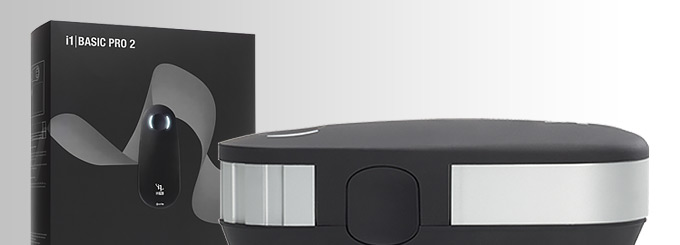
An
important thing to consider for most users is how a screen will perform out of
the box and with some basic manual adjustments. Since most users won't have
access to hardware colorimeter tools, it is important to understand how the
screen is going to perform in terms of colour accuracy for the average user.
We restored our graphics card to default settings
and disabled any previously active ICC profiles and gamma corrections. The
screen was tested at default factory settings using our new
X-rite i1
Pro 2 Spectrophotometer combined with
LaCie's Blue Eye Pro software suite. An X-rite i1 Display Pro colorimeter was
also used to verify the black point and contrast ratio since the i1 Pro 2
spectrophotometer is less
reliable at the darker end.
Targets for these tests are as follows:
-
CIE Diagram - validates the colour space
covered by the monitors backlighting in a 2D view, with the black triangle representing the
displays gamut, and other reference colour spaces shown for comparison
-
Gamma - we aim for 2.2 which is the default
for computer monitors
-
Colour temperature / white point - we aim
for 6500k which is the temperature of daylight
-
Luminance - we aim for 120
cd/m2, which is
the recommended luminance for LCD monitors in normal lighting conditions
-
Black depth - we aim
for as low as possible to maximise shadow detail and to offer us the best
contrast ratio
-
Contrast ratio - we aim
for as high as possible. Any dynamic contrast ratio controls are turned off here
if present
-
dE average / maximum -
as low as possible.
If DeltaE >3, the color displayed is significantly different from the
theoretical one, meaning that the difference will be perceptible to the
viewer.
If DeltaE <2, LaCie considers the calibration a success; there remains a
slight difference, but it is barely undetectable.
If DeltaE < 1, the color fidelity is excellent.

Default Performance and
Setup
Each VP2768 monitor is factory calibrated to deliver a Delta E < 2 and accurate
gamma curve, and includes a detailed calibration report for sRGB, EBU, SMPTE-C,
Rec. 709, and DICOM-SIM colour spaces. Whether you’re a photographer shooting in
sRGB, or a video editor in need of REC 709/SMPT-C/EBU standards, the monitor is
designed to deliver the accuracy you need to complete your best work. To access
any of the factory calibrated modes you need to use the 'Standard Color' menu in
the OSD to select the relevant preset option. We have provided a copy of the
calibration report for our unit which comes in the box with the screen, for
those interested:
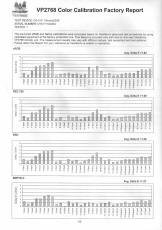
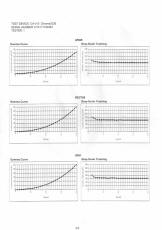
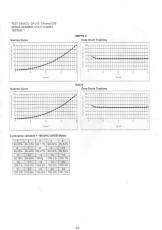
By default the screen is actually set in the 'Custom' user mode which
does not carry any specific factory calibration. We will test that
out-of-the-box setup first of all here.
Default settings of the screen were as follows:
|
Monitor OSD Option |
Default Settings |
|
View mode preset |
Off |
|
Color mode |
Custom |
|
Brightness |
100 |
|
Contrast |
70 |
|
Gamma |
2.2 |
|
Color Temperature |
Native |
|
RGB |
100, 94, 100 |

ViewSonic VP2768
- Default Settings (not factory calibrated)



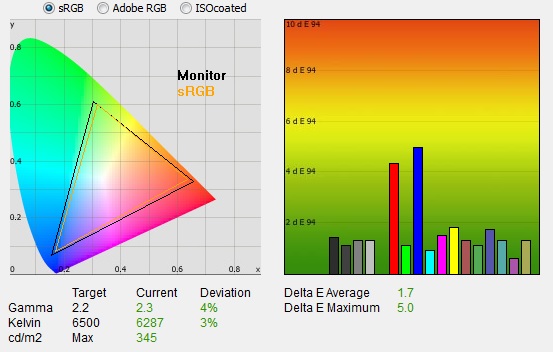

|
|
Default Settings |
|
luminance (cd/m2) |
345 |
|
Black Point (cd/m2) |
0.34 |
|
Contrast Ratio |
1012:1 |
Initially out of the box the screen was set
with a high 100% brightness and so was overly bright and uncomfortable to use, so you will
definitely need to turn that down. You could tell the screen was using a
standard gamut backlight as well with the naked eye, and the colour balance and
temperature felt pretty good and contrast was decent.
We went
ahead and measured the default state with the i1 Pro 2. The
CIE diagram on the left of the image confirms that the monitors colour gamut
(black triangle) is fairly equal to
the sRGB colour space. There is some minor over-coverage in most shades, with a
little under-coverage in some greens but not by anything
significant.
Default gamma was recorded at 2.3 average, leaving it with a minor 4% deviance
from the target which was pretty good. This was with the screen set in the
default 2.2 gamma mode in the OSD. We also tested the other gamma modes which
returned: off = 2.4 (8% out from our target), 1.8 mode = 1.9 measured, 2.0 mode
= 2.1 measured, 2.4 mode = 2.5 measured, 2.6 mode = 2.7 measured. Probably best
to stick with the 2.2 mode for optimal setup.
White
point was measured at a slightly warm 6287k in the default setup where the
colour
temperature mode in the OSD was set to "native". This left the white point 3%
out from the 6500k we'd ideally want for desktop use. We also tested the other
preset colour temperature modes out of interest which returned the following
results for a white point measurement: panel default mode = 6331k, bluish =
9162k, cool = 7430k, native = 6360k, warm = 4944k, user = 6335k. So looks like
the 'user' mode returns a slightly more accurate white point by default, and
will also then allow alterations to the RGB channels for the
calibration
process.
Luminance was recorded at a very bright 345
cd/m2 which is
too high for prolonged general use. The screen was set at a default 100%
brightness in the OSD menu but that is easy to change of course to reach a more
comfortable setting without impacting any other aspect of the setup. The black
depth was 0.34 cd/m2 at this default
brightness setting, giving us a good static contrast ratio for an IPS-type panel of
1012:1.
Colour accuracy was good out of the box
with an average dE of 1.7, although red and blue shades seem to show more
deviance, up to a dE max of 5.0. Testing the screen with colour
gradients showed smooth gradients with only minor gradation evident in darker
tones. There was no sign of any colour banding which was good news.

We went ahead and measured the sRGB factory calibrated mode as well:
|
Monitor OSD Option |
Default Settings |
|
View mode preset |
Off |
|
Color mode |
Standard Color > sRGB |
|
Uniformity |
Off |
|
Brightness |
100 |
|
Contrast |
locked |
|
Gamma |
n/a |
|
Color Temperature |
n/a |
|
RGB |
n/a |

ViewSonic VP2768
- Default Settings (sRGB factory calibrated mode)
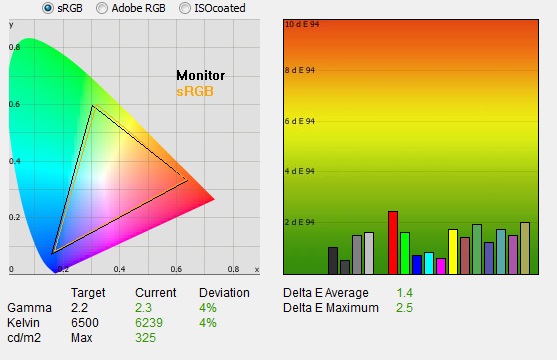

|
|
Default Settings
sRGB mode |
|
luminance (cd/m2) |
325 |
|
Black Point (cd/m2) |
0.34 |
|
Contrast Ratio |
950:1 |
We changed to the Standard Color > sRGB mode
which carries a factory calibration. In this mode first of all you are automatically changed
to a fixed brightness/contrast level and those settings are no longer available
to change. Everything else is preset as well, and if you try to go in to the
'custom' section of the color adjust menu it will revert you back to the custom
mode, and away from the factory calibrated sRGB mode. In this sRGB mode the
uniformity correction feature has been turned on, which is why the
brightness setting is not available. As a result of that function being on, the
luminance is crushed to a lower level through digital white level adjustments.
This depends on what you set the brightness setting to first of all with
uniformity off. For example, with uniformity off and brightness at 100% you get
325
cd/m2, but
as soon as you turn uniformity on it is crushed to around 132 cd/m2.
If you go back and change the brightness to something lower like 25% to achieve
120 cd/m2 with uniformity off, once you turn it back on the luminance
is crushed to around 55 cd/m2! If you want to use the uniformity
function in this sRGB mode, we would recommend turning it off, changing the
brightness setting to around 78% and then turning uniformity back on. That
should result in a luminance output close to 120 cd/m2. You should be
aware also that with uniformity turn on the contrast ratio is crushed as a
result to around 442:1. That is a fairly common occurrence for a uniformity
correction feature and we will talk about that more
later on in
the review.
To avoid this crushed contrast ratio for these measurements, we
turned uniformity correction off.
Testing this mode revealed
a few interesting things. The colour gamut has been slight reduced here to more
closely fit the sRGB space. It's only minor, but you can see some slight
differences in coverage if you compare the CIE diagram on the left, with that
measured in the default custom mode of the screen
here. When you've turned uniformity correction off the gamma curve basically
the same in this factory calibrated
sRGB mode, with the minor 4% deviance we'd seen out of
the box still there. With the uniformity correction function turned on, which is
the default option for the sRGB mode by the way and presumably what was used for
the factory calibration, the gamma curve is closer at 2.2 average with 1% deviance measured.
So the factory calibration has achieved a more accurate gamma curve, albeit only
with uniformity correction turned on.
It's a little
hard to tell from the provided calibrated report what the target was for white
point, but it looks like it has been calibrated to closed to 6000k than the
6500k we normally aim for. We measured it at 6239k with uniformity off, and a
bit warmer at 6036k when it was turned on. Brightness was still too high once
you've turned the uniformity correction off and left yourself with the 100%
default brightness setting. With uniformity correction turn on you get a more comfortable
level of 132
cd/m2, although with
the setting locked in the OSD it was not possible to customise the brightness
any further.
dE was a little more accurate in this sRGB
mode than the out of the box settings, with an average of 1.4 / max of 2.5. The
sRGB factory calibration offered a reasonable performance although you need to
decide if you want uniformity correction turned on or off. At least that option
is available in this mode, and we will test its effectiveness
later on in
the review. With it turned off, the performance was slightly better at least
than the out of the box mode, with a more accurate dE. You will need to turn
down the brightness to something comfortable which is easy enough (once
uniformity correction is turned off).

Calibration
(Software Profiling)
We used the
X-rite i1 Pro 2
Spectrophotometer combined with the LaCie Blue Eye Pro software package to
achieve these results and reports. An X-rite i1 Display Pro colorimeter was used
to validate the black depth and contrast ratios due to lower end limitations of
the i1 Pro device.
|
Monitor OSD Option |
Default Settings |
|
View mode preset |
Off |
|
Color mode |
Custom |
|
Brightness |
25 |
|
Contrast |
70 |
|
Gamma |
2.2 |
|
Color Temperature |
User |
|
RGB |
98, 93, 100 |

ViewSonic VP2768
- Calibrated Settings (Software Profiling)


|
|
Calibrated Settings |
|
luminance (cd/m2) |
120 |
|
Black Point (cd/m2) |
0.12 |
|
Contrast Ratio |
994:1 |
We changed to the 'user' color temperature
mode which
offered us access to the RGB controls from within the menu. We adjusted the RGB
channels and brightness setting as shown in the table above as part of the
guided calibration process. These OSD
changes allowed us to obtain an optimal hardware starting point and setup before software level changes would be
made at the graphics card level. We left the LaCie software to calibrate
to "max" brightness which would just retain the luminance of whatever brightness
we'd set the screen to, and would not in any way try and alter the luminance at
the graphics card level, which can reduce contrast ratio. These adjustments
before profiling the screen would help preserve tonal values and limit
banding issues. After this we let the software carry out the LUT adjustments and create an
ICC profile.
Average gamma was now corrected to 2.2
average a 0% deviance, correcting the 4% deviance we'd seen out of the box. The
white point had now been corrected to 6470k, which corrected the 3% deviance
we'd seen out of the box where the screen was a little too warm. Luminance had
been improved thanks to the adjustment to the brightness control and was now
being measured at 120
cd/m2.
This left us a black depth of 0.12 cd/m2 and maintained a strong IPS static
contrast ratio of
994:1. Colour accuracy of the resulting
profile was excellent, with dE average of 0.4 and maximum of 1.1. LaCie would
consider colour fidelity to be very good.
Testing the screen with various colour gradients
showed mostly smooth transitions with only some very minor banding due to the adjustments to the
graphics card LUT from the profiling of the screen.
You can use our settings and
try our calibrated ICC profile if you wish, which are available in
our ICC profile database. Keep in mind that results will vary from one
screen to another and from one computer / graphics card to another.

Hardware Calibration (updated)
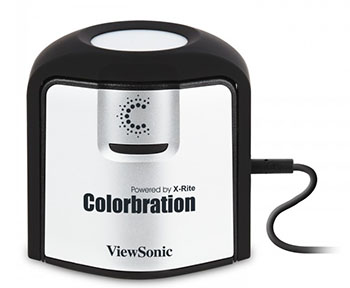
The ViewSonic VP2768 supports hardware level
calibration, allowing you to make adjustments to the internal Look Up Table
(LUT) and to store settings and calibrations within the monitor hardware itself.
This is very useful for professional users to ensure consistent accuracy,
without needing to rely on software profiles at an application level. Because
the calibration is saved in the monitor, it is active no matter what content or
application you are working with.
To hardware calibrate the VP2768 ViewSonic
provide a calibration package (the CS-XRI1 kit) consisting of a colorimeter (an
X-rite i1 Display Pro which they have re-branded as the "ViewSonic Colorbration"
device) and the relevant calibration software. This calibration package is not
provided with the monitor, you have to purchase it separately and it is
currently listed on their website at a retail price of $279.99. We have the kit
with us to test as well. The software is available for free from the
ViewSonic
website and can be used with a normal X-rite i1 Display Pro or i1 Pro / i1
Pro 2 spectrophotometer instead if you have one already, you don't have to buy
the full calibration package from ViewSonic.
The ViewSonic webpage says the following
about the kit: "With the ViewSonic CS-Xri1 Colorbration Kit, you can quickly
and easily calibrate your monitor to maintain superior colour accuracy over
time. The ViewSonic® Colorbration Kit combines innovative colour emitter
hardware and sophisticated profiling software that allows you to calibrate and
profile your monitor, and measure ambient light conditions, while also giving
you infinite control of white point, luminance, contrast ratio, gamma, and more.
This unrivalled colour accuracy and consistency saves you the time, money,
guesswork, and frustration that generally comes with monitor calibration. Now
you can focus on your work, and have complete confidence that the colour
displayed on your monitor is the vivid, lifelike colour that you demand."
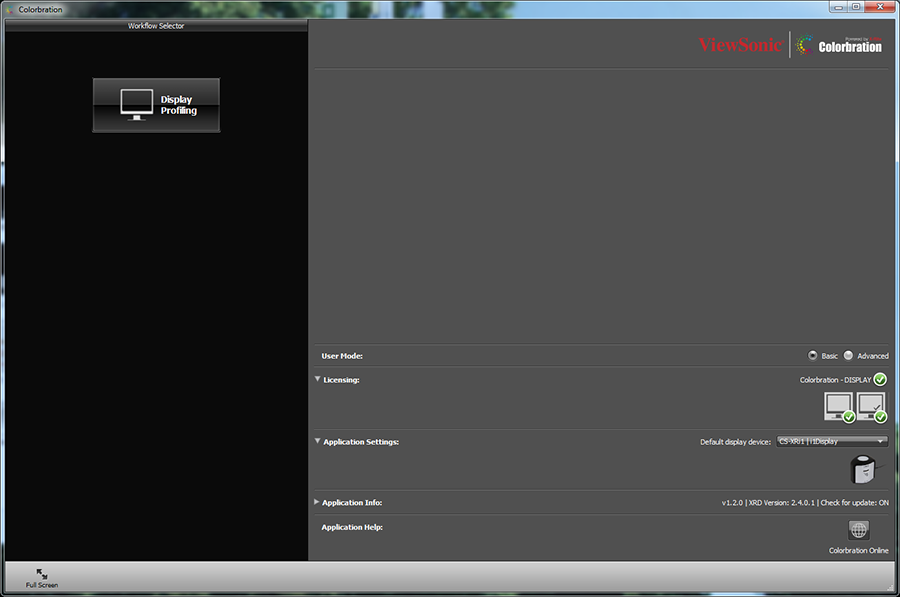
Loading up the software you are presented
with the above home screen. Once a valid device is plugged in, it is verified on
the right with the green ticks. You can move to the "advanced" mode if you want
more options and things to change.
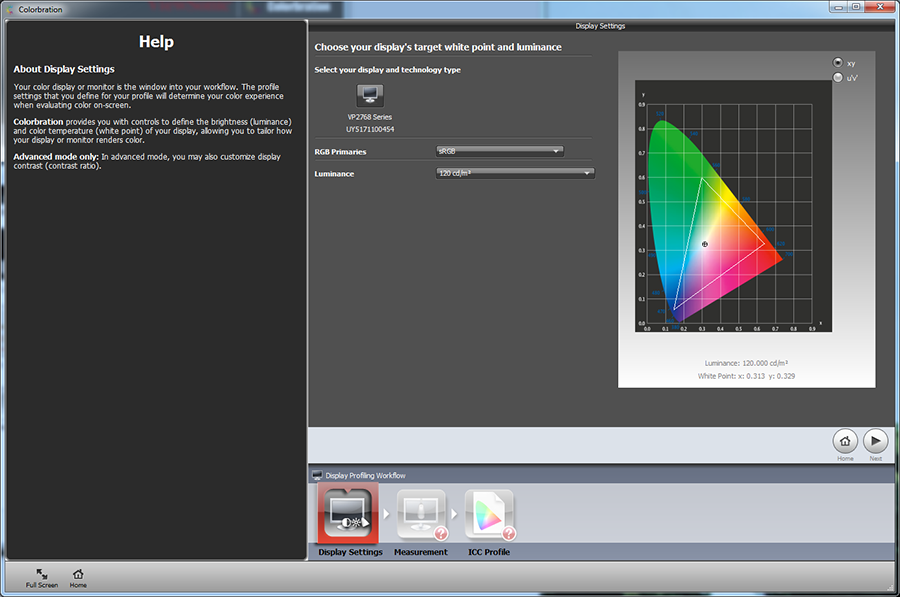
If you press 'display profiling' from the
left, you enter in to the calibration process. You can see that the display is
automatically detected. You need to have connected the screen to your PC using
the provided USB cable for the hardware calibration to function by the way. You
can define targets for colour space and luminance level here.
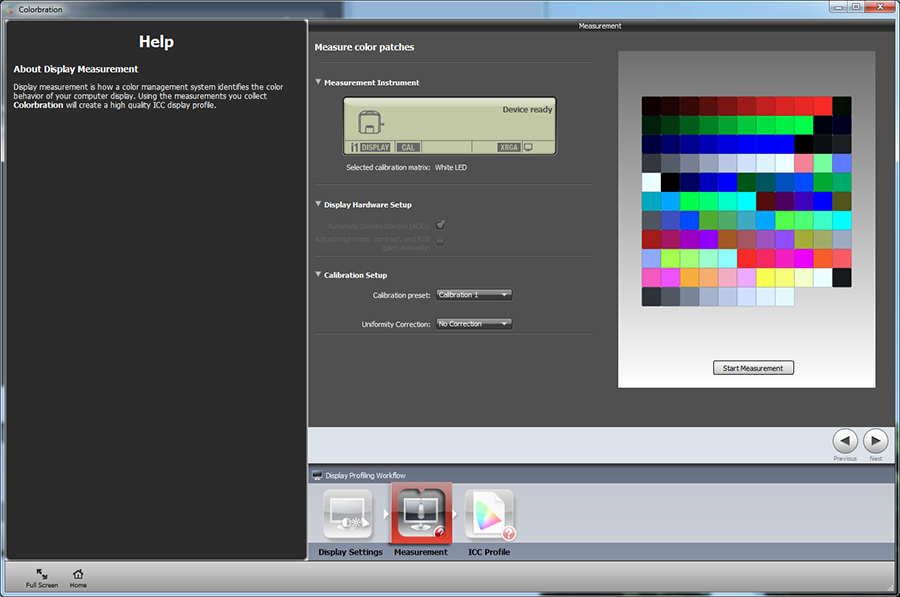
Pressing next takes you the above screen
where the device is confirmed. If the software has correctly detected the screen
you should see the calibration modes listed in a drop down, allowing you to
select which mode you want to hardware calibrate. If not, you would see options
relating to normal software profiling of the screen. There are three CAL modes
available on the VP2768 giving you some flexibility to calibrate to different
requirements and targets. When we first installed the software from the ViewSonic website
(v1.1.0) this hardware calibration detection didn't seem to work, and we were
only able to software profile the screen. After working with ViewSonic to
resolve the problem we were given a new v1.2.0 software which worked fine. You
can 'start measurement' from here to begin the calibration process.
The whole process is then entirely automated
and the screen runs through various tests and corrections. The whole calibration
process takes a long time, around 9 min 15 sec with the ViewSonic Colorbration
device (an X-rite i1 Display Pro), but you can leave it alone to complete as no
user interaction is needed.
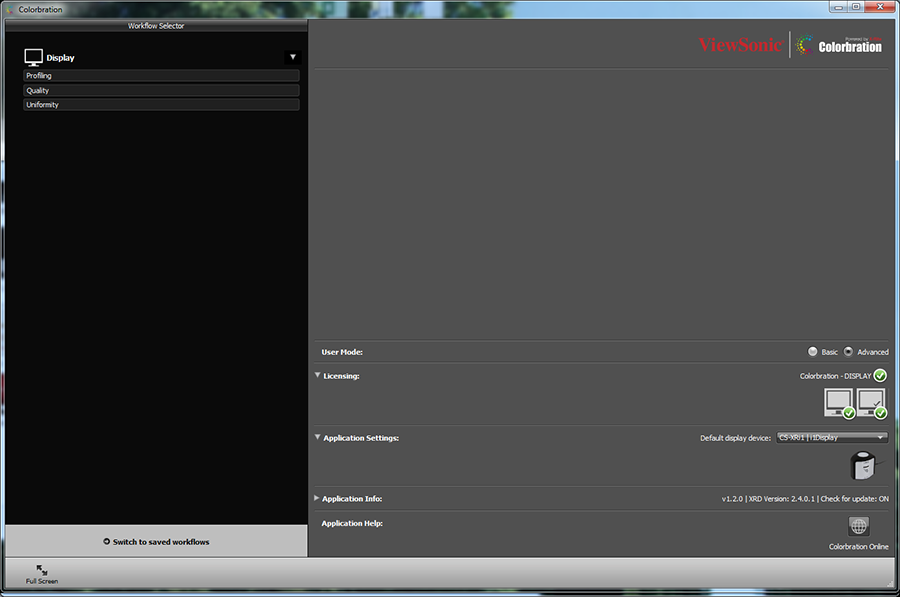
At the end you are only asked to
confirm completion and are not presented with any validation options. You need
to go back to the home screen, change to the 'advanced' option and the use the
'Quality' option from the left which has now appeared.
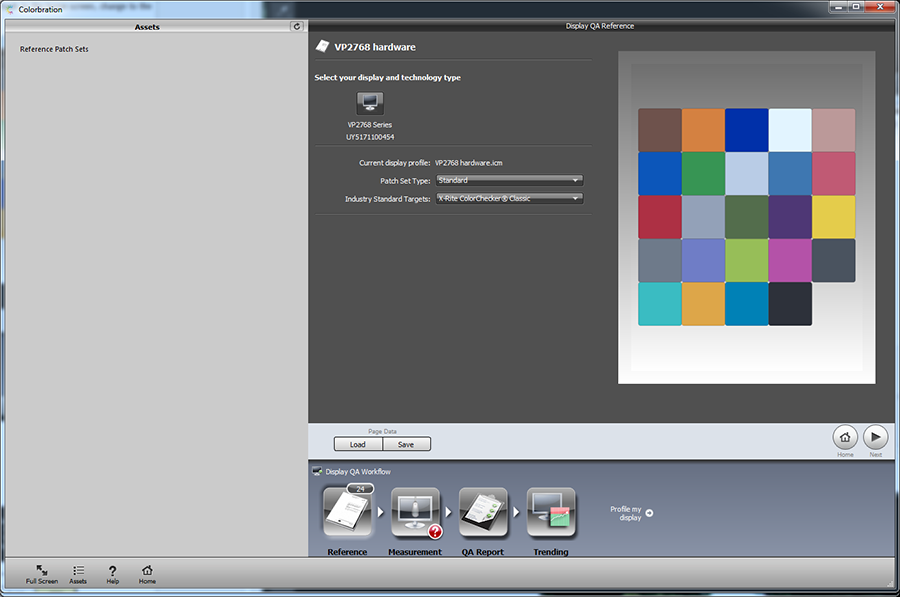
Within the 'Quality' section you can run some
validation steps which are useful. The ColorChecker classic for instance will
run through a series of colour patches and give you deltaE readings.
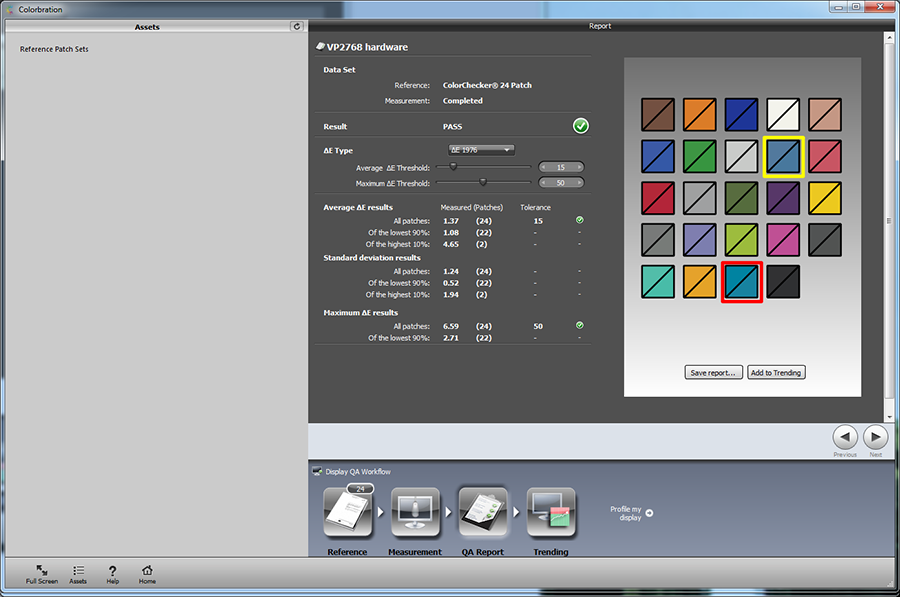
At the end of the validation process you are
presented with a results page like above. Giving you a dE score for all the
measured patches. Different patch samples and methods are available for
validation if you want. Some visual graphs, as well as measurements for white
point, luminance, gamma and contrast would have been useful but don't seem to be
available in the softawre.
We plugged in our i1 Pro 2 spectrophotometer
to validate the results using the familiar LaCie Blue Eye Pro software:

ViewSonic VP2768
- Hardware Calibration
ViewSonic Colorbration device and software
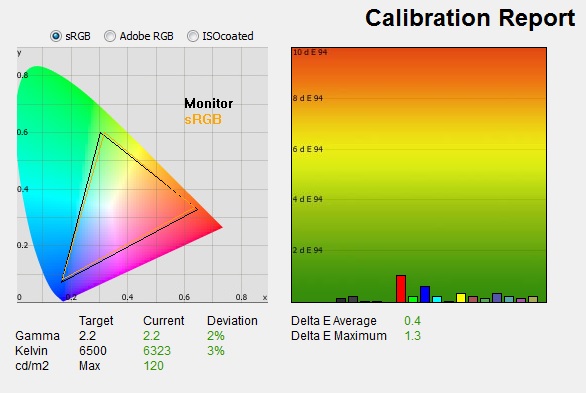
|
|
Calibrated Settings |
|
luminance (cd/m2) |
120 |
|
Black Point (cd/m2) |
0.13 |
|
Contrast Ratio |
901:1 |
The above validation step confirms some very good
results from the hardware calibration process. Keep in mind there is likely to
be some variance in the two instruments used as the screen was calibrated using
the ViewSonic i1 Display Pro colorimeter and validated here with the i1 Pro
spectrophotometer. Nevertheless it confirms a solid result from the hardware
calibration with only minor deviance in gamma and white point. Luminance was
spot on and contrast ratio remained at similar levels to our software calibrated
state at 901:1. The low dE was confirmed here as well.

Calibration Performance Comparisons

The comparisons made in this section try to give
you a better view of how each screen performs, particularly out of the box which
is what is going to matter to most consumers. When comparing the default factory
settings for each monitor it is important to take into account several
measurement areas - gamma, white point and colour accuracy. There's no point
having a low dE colour accuracy figure if the gamma curve is way off for
instance. A good factory calibration requires all 3 to be well set up. We have
deliberately not included luminance in this comparison since this is normally
far too high by default on every screen. However, that is very easily controlled
through the brightness setting (on most screens) and should not impact the other
areas being measured anyway. It is easy enough to obtain a suitable luminance
for your working conditions and individual preferences, but a reliable factory
setup in gamma, white point and colour accuracy is important and not as easy to
change accurately without a calibration tool.
From these comparisons we can also compare the
calibrated colour accuracy, black depth and contrast ratio. After a calibration
the gamma, white point and luminance should all be at their desired targets.

Default setup of the screen out of the box was
good, with a small 4% deviance in gamma and 3% in white point. The dE was 1.7
average as well and we had a strong 1012:1 contrast ratio. This was actually in
a non-factory calibrated mode as well, and the performance improved a little as
we switched to the factory calibrated sRGB mode. That mode also gives you access
to the uniformity correction feature which is very good (see
later in the
review). This was a little better default set up overall than some of the
other 27" IPS models listed here, including the popular
Dell U2715H and
Dell U2717D for instance.


The display was good when it came to static
contrast ratio for an IPS panel at 994:1. Anything around 1000:1 is decent for
this panel technology and it was on par with some other IPS screens shown here.
Some modern IPS panels can reach up closer to 1200:1, and VA panels (not shown
here) can of course reach higher up to over 3000:1.
|
Check Pricing and Buy - Direct Links
|
|
Amazon
|
|
TFTCentral is a participant
in the Amazon Services LLC Associates Programme, an affiliate
advertising programme designed to provide a means for sites to earn
advertising fees by advertising and linking to Amazon.com, Amazon.co.uk,
Amazon.de, Amazon.ca and other Amazon stores worldwide. We also
participate in a similar scheme for Overclockers.co.uk. |

Viewing Angles

Above: Viewing
angles shown from front and side, and from above and below. Click for
larger image
Viewing angles of the screen were very good
as you would expect from an IPS panel. Horizontally there was very little colour
tone shift until wide angles past about 45°. A slight darkening of the image
occurred horizontally from wider angles as you can see above as the contrast
shifted slighting. Contrast shifts were slightly more noticeable in the vertical
field but overall they were very good. The screen offered the wide viewing
angles of IPS technology and was free from the restrictive fields of view of TN
Film panels, especially in the vertical plane. It was also free of the
off-centre contrast shift you see from VA panels and a lot of the quite obvious
gamma and colour tone shift you see from some of the modern VA panel type
offerings.
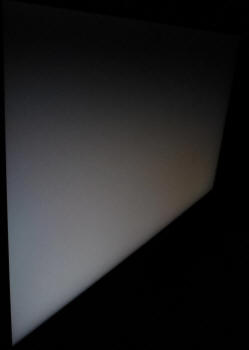
Above: View of an
all black screen from the side. Click for larger version
On a black image there is a characteristic
white glow when viewed from an angle, commonly referred to as "IPS-glow". This
is common on most modern IPS-type panels and can be distracting to some users.
The level of glow here is the same as other recent IPS panels we've seen and is
pretty typical of a modern IPS-type panel. If you view dark content from a
normal head-on viewing position, you can actually see this glow slightly as your
eyes look towards the edges of the screen. Some people may find this problematic
if they are working with a lot of dark content or solid colour patterns. In
normal day to day uses, office work, movies and games you couldn't really notice
this unless you were viewing darker content. If you move your viewing position
back, which is probably likely for movies and games, the effect reduces as you
do not have such an angle from your eye position to the screen edges.

Panel Uniformity
We wanted to test
here how uniform the brightness was across the screen, as well as identify any
leakage from the backlight in dark lighting conditions. Measurements of the
luminance were taken at 35 points across the panel on a pure white background.
The measurements for luminance were taken using BasICColor's calibration
software package, combined with an X-rite i1 Display Pro colorimeter with a
central point on the screen calibrated to 120 cd/m2. The below
uniformity diagram shows the difference, as a percentage, between the
measurement recorded at each point on the screen, as compared with the central
reference point.
It is worth
noting that panel uniformity can vary from one screen to another, and can depend
on manufacturing lines, screen transport and other local factors. This is only a
guide of the uniformity of the sample screen we have for review.

The VP2768 features a uniformity
correction feature which is sometimes available on professional grade screens.
On this model it is available within the following colour
space modes: sRGB, EBU, SMPTE-C, Rec. 709 and is accessible from the 'Manual
Image Adjust' section of the OSD. Above shows the uniformity correction option
at the bottom of this menu, available in certain colour modes only.

Uniformity of Luminance - Correction
OFF
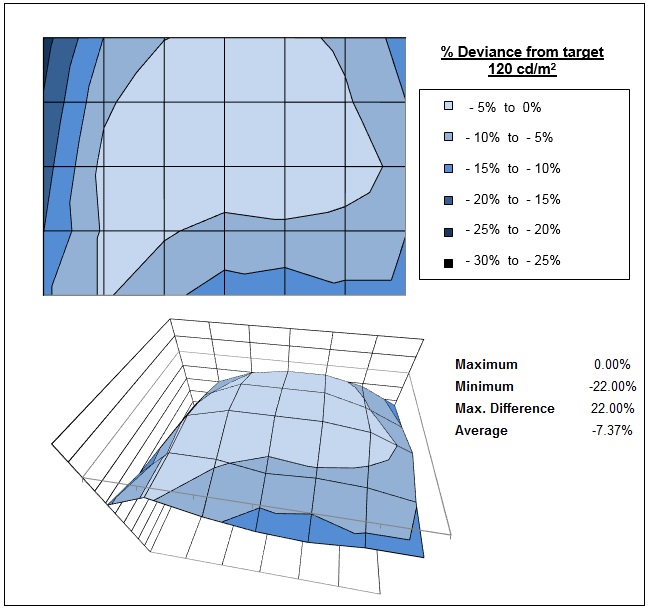
First of all we changed to the sRGB factory
calibrated mode and tested the screen with the uniformity correction feature
turned OFF. We had to manually change the brightness to achieve a centrally
calibrated measurement of 120
cd/m2.
With uniformity correction off we saw the above results. A large portion of the
screen remained within a small 5 - 10% deviance from the centrally calibrated
point, but the luminance did drop down to lower levels along the left hand edge
and bottom right hand area. In the worst cases it dropped by 22% to around 94
cd/m2. Around 80% of the screen was within a 10% deviance though
which was good.

Uniformity of Luminance - Correction
ON
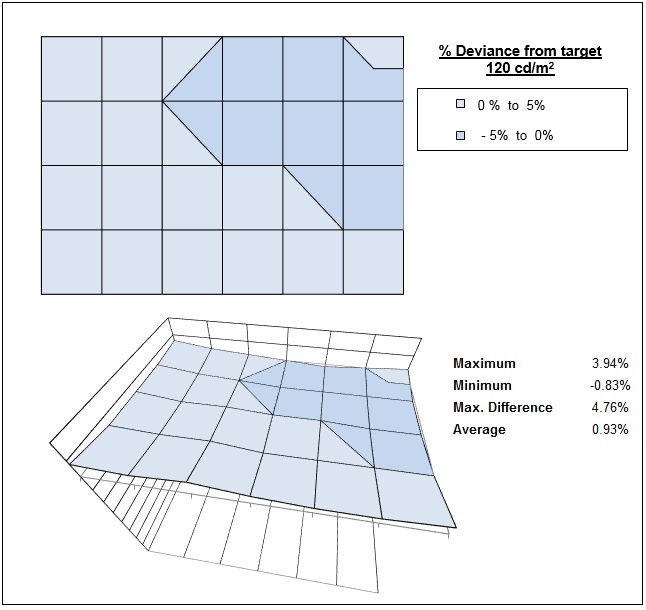
We adjusted the brightness setting to 78%
in the OSD and then turned the uniformity correction feature ON. This locks
the brightness control once it's turned on and this feature makes digital
white level adjustments to the screen in order to try and improve the
uniformity across the panel. In doing so, the luminance output of the screen
is artificially reduced, and we found that by setting the brightness to 78%
first, this turned out as ~120
cd/m2
once uniformity correction was back on. We measured the luminance across the panel
again with the correction function ON.
The luminance uniformity of the screen was
significantly improved and there was now a maximum of 4.76% deviance between
any two points on the screen. This was an excellent result and showed that
the uniformity correction worked really well. You do need to contend with
the loss of the brightness control once it's turned on, so make sure you
find a comfortable setting by switching it off and changing brightness first
of all. You may need to experiment to find the brightness setting which
works for you once uniformity is back on. The main drawback of this, and
other similar uniformity correction features from other manufacturers is
that it does crush the contrast ratio when you use it. We measured a static
contrast ratio of around 420 - 440:1 with uniformity enabled.

Backlight Leakage
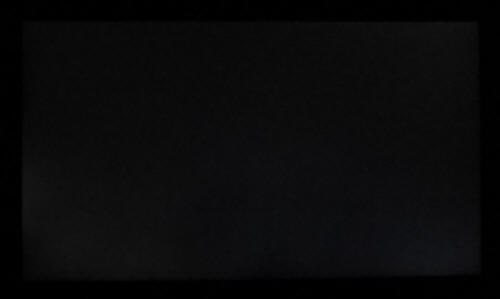
Above: All black screen in a darkened room. Click for larger version
We also tested the screen with an all black image
and in a darkened room. A camera was used to capture the result. The camera
showed there was some clouding evident in the four corners, particularly in the
bottom two corners. If you are in a very dark room working with dark content you
may notice this a little, although in day to day use you would be hard pressed
to see any issue.
Note: if you want to test your own screen for
backlight bleed and uniformity problems at any point you need to ensure you have
suitable testing conditions. Set the monitor to a sensible day to day brightness
level, preferably as close to 120
cd/m2 as you can get it (our tests are
once the screen is calibrated to this luminance). Don't just take a photo at the
default brightness which is almost always far too high and not a realistic usage
condition. You need to take the photo from about 1.5 - 2m back to avoid
capturing viewing angle characteristics, especially on IPS-type panels where
off-angle glow can come in to play easily. Photos should be taken in a darkened
room at a shutter speed which captures what you see reliably and doesn't
over-expose the image. A shutter speed of 1/8 second will probably be suitable
for this.

General and Office Applications
This screen feature a large 2560 x 1440 WQHD
resolution, a significant step up from the wide range of 1920 x 1080 screens on
the market. The pixel pitch of 0.233 mm is quite small as a result, and by
comparison a standard 16:10 format 24" model has a pixel pitch of 0.270mm and a
30" model has 0.250mm. These ultra-high resolution 27" models offer a tight
pixel pitch and therefore small text as well. We found it quite a change
originally coming from 21.5 - 24" sized screens back in the day, even those
offering quite high resolutions and small pixel pitches. Although now we are
very used to working with 27" 1440p screens all the time and find them very
comfortable and a significant upgrade over 1080 / 1200p models. Some users may
find the small text a little too small to read comfortably, and we'd advise
caution if you are coming from a 19" or 22" screen for instance where the pixel
pitch and text are much larger. The extra screen size takes some getting used to
over a few days as there really is a lot of room to work with but once you do,
it's excellent. For those wanting a high resolution for CAD, design, photo work
etc, this is a really good option. The image was very sharp and crisp and text
was very clear.
With its
WQHD display, you enjoy 77% more desktop space than a full HD screen to spread
out your windows and palettes.
The ultra
thin bezel/border design around all 4 edges mean that the screen could be easily
integrated into a multi-screen set up if you wanted. The light AG coating
of the IPS technology panel is certainly welcome, and much better than the older
grainy and 'dirty' appearance of older IPS AG coatings. The
wide viewing
angles provided by this panel technology on both horizontal and vertical planes,
helps minimize on-screen colour shift when viewed from different angles.
The
default setup of the screen was good, especially once you switched to the
factory calibrated sRGB preset, offering a decent gamma curve, accurate white
point, strong contrast ratio and low dE. The added uniformity correction does an
excellent job of improving the luminance stability across the screen, although
you do need to contend with a crushed contrast ratio if you use it.
The
brightness range of the screen was excellent, with the ability to offer a
luminance between 333 and 45 cd/m2 (uniformity correction off). This should mean the screen is
useable in a wide variety of ambient light conditions, including darkened rooms.
A setting of ~25 in the OSD brightness control should return you a luminance
close to 120 cd/m2 out of the box. On another positive note, the
brightness regulation is controlled without the need for
Pulse-Width Modulation (PWM), and so those who suffer from eye fatigue or
headaches associated with flickering backlights need not worry.
There are a
couple of extras provided here as well including a 4 port USB 3.0 hub with all
ports on the underside of the screen. It might have been nice to have a couple
of these on the side of the screen for easy access. There is also an audio output for speaker
connection. There were no further extras such as ambient light sensors or card
readers on this model which can be useful in office environments.
There was a good range of ergonomic
adjustments available from the stand allowing you to obtain a comfortable
position for a wide variety of angles. The VESA mounting support may also be
useful to some people as well.

Above: photo of text at 2560 x 1440 (top) and 1920 x 1080 (bottom)
The screen is designed to run at its native
resolution of 2560 x 1440 and at a 60Hz recommended refresh rate. However, if
you want you are able to run the screen outside of this resolution. We tested
the screen at a lower 1920 x 1080 resolution to see how the screen handles the
interpolation of the resolution, while maintaining the same aspect ratio of
16:9. At native resolution the text was sharp and clear. When running at a the
lower resolution the text is still reasonably clear, with fairly low levels of
blurring. You do lose a lot of screen real-estate as well of course.

Responsiveness and Gaming
|
Quoted G2G Response Time |
14ms G2G |
|
Quoted ISO Response Time |
n/a |
|
Panel Manufacturer and
Technology |
LG.Display IPS |
|
Panel Part |
LM270WQ5-SSA1 |
|
Overdrive Used |
Yes |
|
Overdrive Control Available to
User |
Response Time |
|
Overdrive Settings |
Standard, Advanced, Ultra
Fast |
The VP2768 is rated by ViewSonic as having a
14ms G2G
response time. This is a little odd as that would imply that the screen maybe
does not use
overdrive /
response time compensation (RTC) technology to boost pixel transitions
across grey to grey changes, as a figure of 14ms is not very aggressive in
today's market. However, we know that the OSD menu offers various
options for Response Time control, so overdrive must be used on this model. We
will test the actual response times in a moment, but we suspect ViewSonic could
have been more aggressive with their response time spec here if they wanted to. Given this is not
really aimed at gaming, and is a professional range screen, we suppose it's
perhaps not something they were concerned with. The
part
being used is the
LG.Display LM270WQ5-SSA1 IPS technology panel. Have a read about response time in
our
specs section if you need additional information about this measurement.
We will first test the screen using our thorough
response time testing method. This uses an oscilloscope and photosensor to
measure the pixel response times across a series of different transitions, in
the full range from 0 (black) to 255 (white). This will give us a realistic view
of how the monitor performs in real life, as opposed to being reliant only on a
manufacturers spec. We can work out the response times for changing between many
different shades, calculate the maximum, minimum and average grey
to grey (G2G) response times, and provide an evaluation of any overshoot present
on the monitor.
We use an
ETC M526
oscilloscope for these measurements along with a custom photosensor device.
Have a read of
our response time measurement article for a full explanation of the testing methodology and reported
data.

Response Time Setting
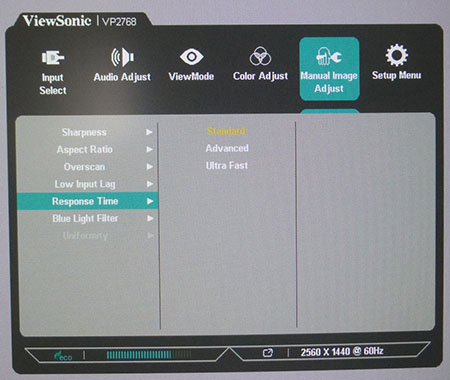
The 'Response Time' setting is available via the
'Manual Image Adjust' section of the OSD menu as shown above. We will test the modes to see which is optimal
first of all.



In the 'standard' Response Time setting we
recorded an average figure of 13.6ms G2G, basically meeting the advertised spec
for the screen of 14ms G2G. Transitions from dark to light shades (rise times)
were particularly slow up to around 20ms. In this setting there was no overshoot
at all but the slow response times lead to noticeable blurring of moving images.
If you switch up to the 'Advanced' setting
the results are better and you can see an obvious improvement in motion clarity
with the naked eye. Average G2G response time had now been dropped down to 8.6ms
G2G which is a much better performance and showed improvements in the levels of
blurring in practice. A small amount of overshoot started to creep in but you
shouldn't notice this in practice. The highest 'Ultra Fast' mode was too
aggressive with the overdrive impulse, driving response times down a bit to
7.1ms G2G, but at the cost of some high levels of overshoot which became
apparent in practice. To be fair the dark halos were not majorly obvious, but
you can still see them (see our PixPerAn images below for example). Stick with
the 'Advanced' setting for optimal response time behaviour on this screen which
is on par with the better 60Hz IPS panels around.

The above images give you an indication of
the blurring and overshoot levels in each of the Response Time overdrive modes, using the PixPerAn test
tool. Responsiveness improves as you change from standard > advanced mode with
less blurring and a sharper, clearer moving image. The Ultra Fast mode starts to
introduce some dark halos behind the moving object and the overdrive impulse is
probably a bit too aggressive in that mode.

Display Comparisons
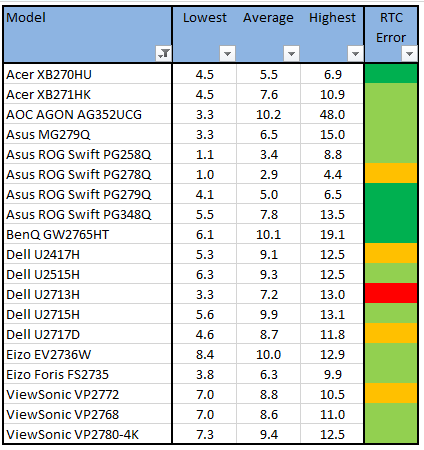
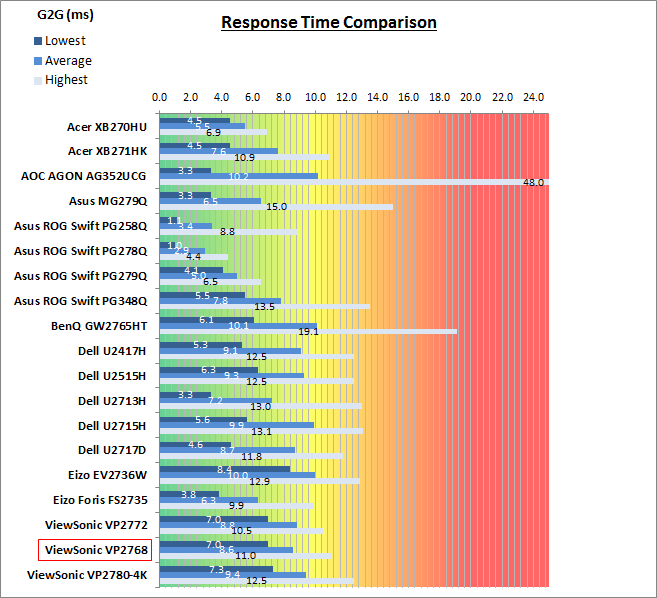
The above comparison table and graph shows you the
lowest, average and highest G2G response time measurement for each screen we
have tested with our oscilloscope system. There is also a colour coded mark next
to each screen in the table to indicate the RTC overshoot error, as the response
time figure alone doesn't tell the whole story.
As a reminder, these measurements were in the
optimal 'Advanced' Response Time overdrive mode. With an average of 8.6ms G2G
and low levels of overshoot the VP2768 performed well for an IPS panel, and in
line with some of the better 60Hz IPS models we have tested to date. Response
times of around this 8.6ms seem to be about the best manufacturers can achieve
with a native 60Hz refresh rate, from this panel technology, and so it was
pleasing that the VP2768 had performed well here. The high refresh rate IPS
models like the
Asus ROG Swift PG279Q (5.0ms G2G) and
MG279Q (6.5ms G2G) for
instance had performed better, and TN Film models like the
Asus ROG Swift PG278Q
(2.9ms G2G) could of course reach faster speeds and are specifically designed
for gaming audiences. Considering the VP2768 is not
aimed at gamers really, it performed admirably for a 60Hz IPS panel and should
be able to handle general gaming fine.

Additional Gaming Features

Aspect Ratio Control -
the screen offers 3 options for
aspect ratio control,
available through the OSD menu in the 'manual image adjust' section as shown. There
are options for 1:1 pixel mapping, 4:3 mode and 'full screen'. This should suit
most people's needs, especially since most graphics cards can handle scaling for
you as well when connected to a PC. It might have been good to also include an
'aspect' option, to maintain the input aspect ratio but scale it to fill as much
of the screen as possible, instead of just 1:1 pixel mapping it.
Preset Modes -
There are 4 gaming preset modes available in
the 'ViewMode' menu. There are options for FPS1, FPS2, RTC and MOBA and each can
be customised to your liking and saved which is handy.

Lag
We have written an in depth article about
input lag and the various measurement techniques which are used to evaluate
this aspect of a display. It's important to first of all understand the
different methods available and also what this lag means to you as an end-user.
Input Lag vs. Display Lag vs. Signal
Processing
To avoid confusion with different terminology we
will refer to this section of our reviews as just "lag" from now on, as there
are a few different aspects to consider, and different interpretations of the
term "input lag". We will consider the following points here as much as
possible. The overall "display lag" is the first, that being the delay between
the image being shown on the TFT display and that being shown on a CRT. This is
what many people will know as input lag and originally was the measure made to
explain why the image is a little behind when using a CRT. The older stopwatch
based methods were the common way to measure this in the past, but through
advanced studies have been shown to be quite inaccurate. As a result, more
advanced tools like SMTT provide a method to measure that delay between a TFT
and CRT while removing the inaccuracies of older stopwatch methods.
In reality that lag / delay is caused by a
combination of two things - the signal processing delay caused by the TFT
electronics / scaler, and the response time of the pixels themselves. Most
"input lag" measurements over the years have always been based on the overall
display lag (signal processing + response time) and indeed the SMTT tool is
based on this visual difference between a CRT and TFT and so measures the
overall display lag. In practice the signal processing is the element which
gives the feel of lag to the user, and the response time of course can
impact blurring, and overall image quality in moving scenes. As people become
more aware of lag as a possible issue, we are of course keen to try and
understand the split between the two as much as possible to give a complete
picture.
The signal processing element within that is quite
hard to identify without extremely high end equipment and very complicated
methods. In fact the studies by Thomas Thiemann which really kicked this whole
thing off were based on equipment worth >100,1000 Euro, requiring extremely high
bandwidths and very complicated methods to trigger the correct behaviour and
accurately measure the signal processing on its own. Other techniques which are
being used since are not conducted by Thomas (he is a freelance writer) or based
on this equipment or technique, and may also be subject to other errors or
inaccuracies based on our conversations with him since. It's very hard as a
result to produce a technique which will measure just the signal processing on
its own unfortunately. Many measurement techniques are also not explained and so
it is important to try and get a picture from various sources if possible to
make an informed judgement about a display overall.
For our tests we will continue to use the SMTT
tool to measure the overall "display lag". From there we can use our
oscilloscope system to measure the response time across a wide range of grey to
grey (G2G) transitions as recorded in our
response time
tests. Since SMTT will not include the full response time within its
measurements, after speaking with Thomas further about the situation we will
subtract half of the average G2G response time from the total display lag. This should allow us to give a good estimation of
how much of the overall lag is attributable to the signal processing element on
its own.
Lag Classification
To help in this section we will also introduce a broader classification system
for these results to help categorise each screen as one of the following levels:
-
Class 1)
Less than 16ms / 1 frame lag at 60Hz - should be fine for gamers, even at high levels
-
Class
2)
A lag of 16 -
32ms / One to two frames at 60Hz - moderate lag but should be fine for many gamers.
Caution advised for serious gaming
-
Class
3)
A lag of more
than 32ms / more than 2 frames at 60Hz - Some noticeable lag in daily usage, not
suitable for high end gaming
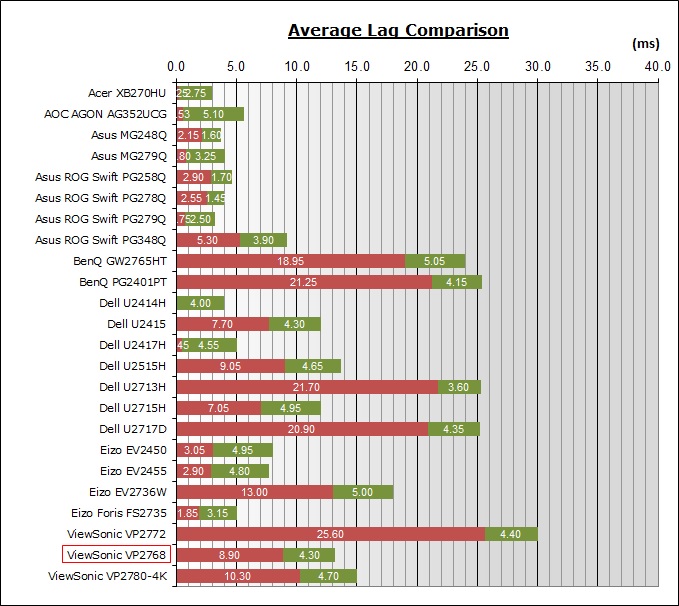
For the full reviews of the models compared here and the dates they were written
(and when screens were approximately released to the market), please see our
full
reviews index.
|
(Measurements in ms) |
Off |
Advanced |
UltraFast |
|
Total Display Lag (SMTT
2) |
24.50 |
24.50 |
13.20 |
|
Pixel Response Time
Element |
4.30 |
4.30 |
4.30 |
|
Estimated Signal
Processing Lag |
20.20 |
20.20 |
8.90 |
|
Lag Classification |
2 |
2 |
1 |
|

Class
1 |
We have provided a comparison above against other
models we have tested to give an indication between screens. The screens
tested are split into two measurements which are
based on our overall display lag tests (using SMTT) and half the average G2G
response time, as measured by the oscilloscope. The response time is split from
the overall display lag and shown on the graph as the green bar. From there, the
signal processing (red bar) can be provided as a good estimation.
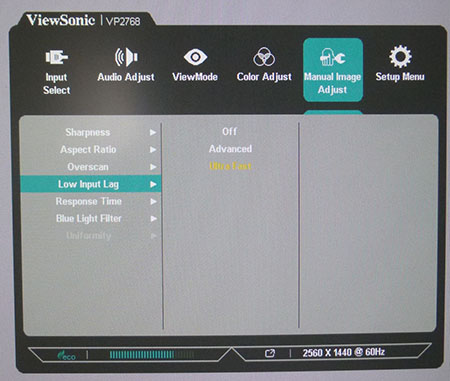
The screen has three modes for 'low input
lag' in the OSD menu as shown above. We tested the lag in each setting. The
'off' and 'advanced' modes seemed to be identical, showing a total display lag
of 24.50ms. With a 4.3ms G2G response time element considered, the signal
processing lag in those two models was around 20.2ms. When you switch up to the
'UltraFast' input lag mode you get some improvements thankfully. Total display
lag dropped to 13.20ms, giving us a signal processing estimate of ~8.9ms. This
was just over half a frame at 60Hz and represented a
decent lag. Especially considering this is not a gaming screen per se.

Movies and Video

The following summarises the screens performance
in video applications:
-
27"
screen size makes it a reasonable option for an all-in-one multimedia screen,
much smaller than LCD TV's and many larger format desktop monitors which are
now emerging.
-
16:9
aspect ratio is more well suited to videos than a 16:10 format screen, leaving
smaller borders on DVD's and wide screen content at the top and bottom.
-
2560 x
1440 resolution can support full 1080 HD resolution content.
-
Digital interfaces support HDCP for any encrypted and protected content
-
Good range of connectivity options provided
with DisplayPort, Mini DisplayPort and 2x HDMI offered.
-
Cables provided in the box
for DisplayPort to
Mini DP only.
-
Light
AG coating providing clean and clear images, without the
unwanted reflections of a glossy solution.
-
Wide brightness range adjustment possible from the display, including a
maximum luminance of ~333
cd/m2 and a decent minimum
luminance of 45 cd/m2. This should afford you good control for different
lighting conditions. Contrast ratio remains stable across that adjustment
range as well and is good for an IPS-type panel. Brightness regulation is
controlled without the need for PWM and so is flicker free for all brightness
settings.
-
Black
depth and contrast ratio are good for an IPS-type panel at 994:1 after
calibration. Detail in darker scenes should not be lost as a result.
-
There
is a specific 'movie' preset mode available for movies or video if you want
but it is cooler than our calibrated custom mode. May be useful to some though.
-
Good
pixel responsiveness which should still be able to handle fast moving scenes
in movies without issue. Stick with the 'advanced' response time setting for
optimal performance.
-
Wide viewing angles thanks to IPS-type panel
technology meaning several people could view the screen at once comfortable
and from a whole host of different angles.
-
IPS glow is at a normal level meaning you might
experience some annoying white glows on darker content from an angle.
-
Very good and easy to use range of
ergonomic adjustments available from the stand, so should be easy to obtain a
comfortable position for multiple users or if you want to sit further away
from the screen for movie viewing.
-
No
particularly major backlight leakage, and none from the edges which is
good. This type of leakage may prove an issue when watching movies where black
borders are present but it is not a problem here.
-
No integrated stereo speakers on this model but there is an audio put
connection if you want.
-
Decent
range of
hardware aspect ratio options with 1:1 pixel mapping, full screen and 4:3 modes available which
should be fine for most uses.
-
Picture in picture (PiP) and Picture By Picture (PbP) are not available.

Conclusion
The VP2768 was overall a very good display.
While it is aimed at professional users specifically we felt that it fit a more
all-round user market as well.For professional users ViewSonic have opted to
leave off some common high end features like wide gamut and 10-bit colour depth
support in favour of keeping the retail costs down, and instead focused on
producing a quality screen for standard sRGB colour space uses. Wide gamut and
10-bit are still fairly niche and not everyone will want to pay the extra for
those features when they are just looking for a quality, accurate screen for
their more standard applications. The VP2768 does a nice job providing in that
area with a reliable factory calibration, wide range of preset modes and options
and support for hardware calibration. The uniformity correction feature is also
reserved for professional screens, and on the VP2768 it works really well which
was great news. For the intended audience, the VP2768 performs very well.
We were actually also quite impressed with
the performance in other areas which is why we felt it helped make the VP2768 a
very good all-round choice. Clearly ViewSonic are not aiming this screen at
gamers, even advertising a high 14ms G2G response time in their spec. In fact we
were impressed by the unexpectedly good performance for gaming, with response
times matching the better 60Hz IPS models around and input lag also being pretty
low. Of course the screen lacks additional gaming enhancements like a high
refresh rate or motion blur reduction backlight, but it's still decent enough
for general gaming and multimedia.
The appearance of the screen was very nice
and we like the 4-side thin border design. The stand offers a good range of
adjustments and there's plenty of connectivity options. The OSD menu was a bit
fiddly to use and the control buttons didn't feel very intuitive, but there was
at least a wide range of options to play with. All in all it was a very good all
round performer, with some advanced features for professional audiences which
help to separate it from the competition.
If you appreciate this review and enjoy reading and like our work, we would welcome a
donation
to the site to help us continue to make quality and detailed reviews for you.
|
Pros |
Cons |
|
Decent factory
calibration and wide range of modes and options available, including
hardware calibration support |
Contrast ratio is crushed
a lot when uniformity correction is used |
|
Uniformity correction
works very well |
OSD menu is fiddly to use |
|
Unexpectedly decent
response times and low lag |
Missing wide gamut
support which some professional users might want |
|
Check Pricing and Buy - Direct Links
|
|
Amazon
|
|
TFTCentral is a participant
in the Amazon Services LLC Associates Programme, an affiliate
advertising programme designed to provide a means for sites to earn
advertising fees by advertising and linking to Amazon.com, Amazon.co.uk,
Amazon.de, Amazon.ca and other Amazon stores worldwide. We also
participate in a similar scheme for Overclockers.co.uk. |
|
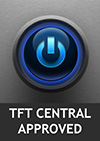
|
TFT Central Awards Explained
We have two award
classifications as part of our reviews. There's the top 'Recommended'
award, where a monitor is excellent and highly recommended by us. There is
also an 'Approved' award for a very good screen which may not be perfect,
but is still a very good display. These awards won't be given out every
time, but look out for the logo at the bottom of the conclusion. A list of
monitors which have won our awards is available
here. |